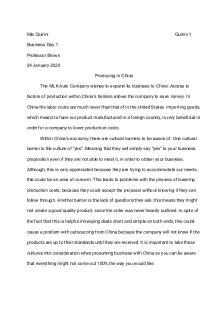Case Study ASOS in China PDF

| Title | Case Study ASOS in China |
|---|---|
| Author | NAN ZHANG |
| Course | Strategic Marketing |
| Institution | University of Manchester |
| Pages | 2 |
| File Size | 51.3 KB |
| File Type | |
| Total Downloads | 47 |
| Total Views | 214 |
Summary
Case StudyASOS: The failure of ASOSAuthor: Barbara WatersIntroduction ASOS is a successful British online retailer selling mid-market fashion aimed at twentysomethings. The company was founded in London in 2000 and initially focused on selling items that had been seen in ilms and on TV (hence its or...
Description
Case Study ASOS: The failure of ASOS.cn Author: Barbara Waters Introduction ASOS is a successful British online retailer selling mid-market fashion aimed at twentysomethings. The company was founded in London in 2000 and initially focused on selling items that had been seen in films and on TV (hence its original name: As Seen On Screen), however the business quickly expanded, launching its own clothing label in 2004. ASOS now sells a huge range of branded and own label fashion items, shipping to 196 countries from fulfilment centres in the UK, US and EU. In 2013 ASOS decided to set up an online store in China, servicing it from a local warehouse rather than shipping directly from the UK. The company spent £9m launching this operation, but failed to win over China’s fashion shoppers. In 2016, just three years after the launch, ASOS announced that it would be closing its Chinese operation, and instead would serve Chinese customers through its global website, shipping the clothes from Europe. Industry commentators have suggested that there were 5 main reasons for the failure of ASOS’s Chinese operation: 1. Difficulties adapting to local requirements ASOS struggled to adapt to complex regulations in the Chinese clothing market, in particular, labelling requirements (e.g.: materials, washing instructions etc.). Because ASOS sells hundreds of different brands, relabelling was very complex and costly, leading to widespread re-stitching of labels. In addition to labelling requirements, the brand was also accused of selling clothing in sizes and cuts that didn’t suit the local Chinese body type. The company also faced difficulties working with the Chinese postal service. 2. The scale of China as a country China is a huge country with many regions and climates. Therefore one seasonal range of clothing was found to be insufficient to satisfy the whole market. In addition, ASOS was also criticised for not stocking a wide enough range. The local ASOS.cn store was only able to offer around 6000 styles, compared to the global ASOS store, which offers around 80,000. 3. The strength of local competition
ASOS found that they faced tough competition from local e-commerce companies, such as Alibaba (which controls around 80% of the Chinese ecommerce market) and JD.com. Although ASOS had a presence on Alibaba’s TMall platform, it struggled to gain brand awareness, making it hard for ASOS.cn to succeed. 4. The stalling Chinese economy The period 2013 to 2016 saw a slowdown in economic growth in China. Although Chinese growth was relatively strong (6.9% in 2015) compared to other markets, it was still slower than anticipated and one of the lowest rates of growth for China in the last 25 years. This, combined with Chinese yuan devaluation. had an impact on the spending of the middle classes in China. 5. ASOS’s brand cachet was not strong enough ASOS failed to compete successfully with local fashion brands. Whilst China has been a very successful market for international luxury brands, mid-market brands, such as ASOS have struggled to succeed in the Chinese market. Chinese consumer behaviour has been described as following an “Hour Glass Shopping Model”. Chinese consumers buy products at the top and bottom of the market, but nothing in the middle. High end, luxury products are seen as worth buying because they offer prestige and status, but Chinese consumers like bargain hunting, and expect great value and very cheap prices on other goods. Mid-market brands struggle because their products aren’t exceedingly cheap, but don’t offer status or prestige, so they are not seen as offering good value. Sources: This case study has been compiled using secondary sources, primarily: https://www.theguardian.com/business/2016/apr/07/asos-closes-onlinestore-china-after-10m-loss-fashion-website https://econsultancy.com/five-reasons-asos-is-pulling-out-of-china/ https://www.translatemedia.com/translation-blog/western-fashion-brandswrong-china/...
Similar Free PDFs

Case Study ASOS in China
- 2 Pages

Zara in China and India Case study
- 26 Pages

Case study #12 MMC in China
- 1 Pages

China Case Study
- 6 Pages

China Walmart CASE Solved
- 4 Pages

Producing in China Essay
- 3 Pages

HR Challenges in China
- 6 Pages

Commercial Revolution in China
- 2 Pages

Bevölkerungspolitik in China
- 13 Pages

Swisse In China - Project
- 26 Pages
Popular Institutions
- Tinajero National High School - Annex
- Politeknik Caltex Riau
- Yokohama City University
- SGT University
- University of Al-Qadisiyah
- Divine Word College of Vigan
- Techniek College Rotterdam
- Universidade de Santiago
- Universiti Teknologi MARA Cawangan Johor Kampus Pasir Gudang
- Poltekkes Kemenkes Yogyakarta
- Baguio City National High School
- Colegio san marcos
- preparatoria uno
- Centro de Bachillerato Tecnológico Industrial y de Servicios No. 107
- Dalian Maritime University
- Quang Trung Secondary School
- Colegio Tecnológico en Informática
- Corporación Regional de Educación Superior
- Grupo CEDVA
- Dar Al Uloom University
- Centro de Estudios Preuniversitarios de la Universidad Nacional de Ingeniería
- 上智大学
- Aakash International School, Nuna Majara
- San Felipe Neri Catholic School
- Kang Chiao International School - New Taipei City
- Misamis Occidental National High School
- Institución Educativa Escuela Normal Juan Ladrilleros
- Kolehiyo ng Pantukan
- Batanes State College
- Instituto Continental
- Sekolah Menengah Kejuruan Kesehatan Kaltara (Tarakan)
- Colegio de La Inmaculada Concepcion - Cebu





